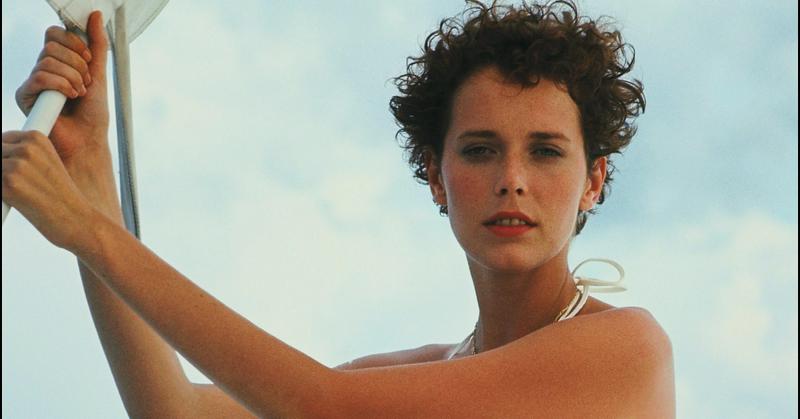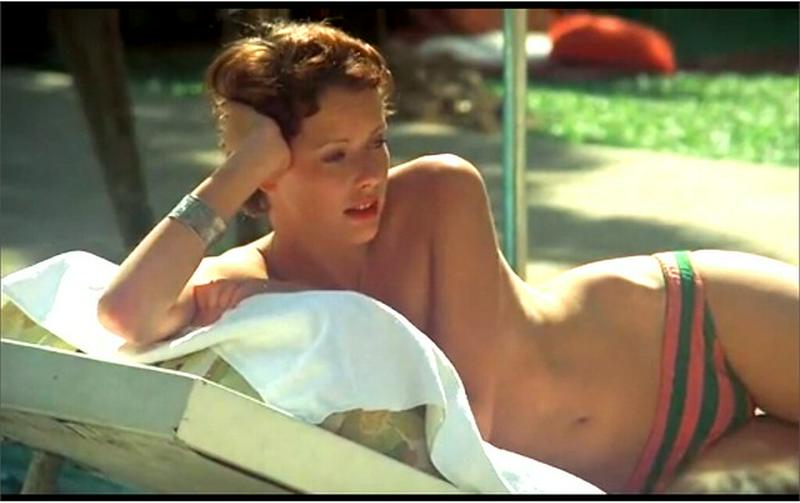'Emmanuelle' Starring Sylvia Kristel And The 'Skinemax' Phenomenon
By | December 2, 2020

In 1974, Dutch actress Sylvia Kristel played a youthful model who moves to Thailand to be with her husband, a French diplomat. The film was Emmanuelle, and it depicted Kristel's character on an erotic journey that changes the direction of her life forever. Emmanuelle initially earned a reputation as a sophisticated blue movie before forming the basis of the cable-TV smutty flick revolution of the 1980s and early '90s.
Without meaning to, the Emmanuelle film series created an entire genre of pseudo-adult films that were shown late at night on paid cable networks like Cinemax, with its "Friday After Dark" franchise, inspiring teenage boys to stay up to ungodly hours of the night with hopes of catching a hint of sexuality. These films, some of which initially built a large following with female viewers during the '70s, became a rite of passage for young people a decade later.
Without trying to, this sultry drama became the highest-grossing domestically produced French film of 1974, and created an aesthetic and tone for countless imitators and the Skinemax phenomenon.
Why 'Emmanuelle?'

Some film historians trace the beginning of this subgenre to a film that was actually much more high profile, due to its male lead Marlon Brando and its director Bernardo Bertolucci. Released at the tail end of 1972, just months after Brando's Oscar-worthy turn in The Godfather, Bertolucci's Last Tango in Paris became one of the highest grossing films of the net year, and finally ended up making more than $96 million on a $1.25 million budget. This box office windfall proved that there was an audience for arty erotic dramas made for adults.
Producer Yves Rousset-Rouard snapped up the rights to Emmanuelle, a pseudo-memoir published (and reportedly banned) in France in 1959 and credited to “Emmanuelle Arsan,” which was either the nom de plume of Marayat Rollet-Andriane, a Thai writer who appeared in The Sand Pebbles with Steve McQueen or her husband, a UNESCO diplomat named Louis-Jacques Rollet-Andriane. Either way, the book was a touchstone of erotic literature and Rousset-Rouard felt that it was ripe for an artistically sexy adaptation.
Sylvia Kristel Was Born To Play Emmanuelle

Born in Utrecht, Netherlands, in 1952, Kristel was the daughter of hoteliers. Raised Calvinist and schooled in a convent, when she wasn't receiving a religious education she was living in Room 21 of her parent's palatial hotel. Her life was like something out of dramatic novel: she was abused by someone staying at the hotel when she was 9, she started smoking and drinking when she was 11, and saw her father in bed with another woman when she was 14. Shortly afterwards Kristel's father abandoned the family, leaving her to quit school and work as a secretary and waitress to take care of her family.
In the 1970s she was a sometime model, sometime beauty pageant contestant, living in Amsterdam and dating a Belgian writer and filmmaker named Hugo Claus. He told her to try acting so she gave it a whirl. By the time she heard that Rousset-Rouard was producing Emmanuelle she had already appeared in three Dutch films. In Emmanuelle: A Hard Look, a 2000 documentary by Repo Man director and exploitation-cinema stalwart Alex Cox, she explained how she got the part that changed her life:
I thought, ‘Well, knowing directors, they’ll probably ask you to undress.' So I picked a very slinky, beautiful silky dress with spaghetti straps, and while [the producer] was interviewing me, I was telling a story — I don’t know, about my family, or whatever — and then dropped the dress in the middle of the speech, and just went on talking.
Not That Kind Of X Rating

Yes, Emmanuelle is rated X, and it has plenty of nudity and scenes that you're not going to see in a modern adult drama, but if you're looking for something sleazy or explicit, you will be very disappointed in this film. Aside from a questionable scene in an opium den and a kick boxing ring, Emmanuelle is a sophisticated, sensual look at sexual exploitation.
The film follows a young woman who moves to Bangkok from France to be with her husband and experiences a sexual awakening, with the permission of her husband. The aesthetics of the film are gauzy and detached, and the sex that does happen mostly pushes the storyline along. Somehow, the film remains classy in spite of everything we as an audience have been told about the crass morals of films with sexual overtones. At the time, the film was scandalous, but today audiences would probably feel like the film was just kind of slow.
60 Million Frenchmen Can't Be Wrong

Emmanuelle was released in France on June 26, 1974, and was an immediate hit, creating such a stir among female audience members that Columbia Pictures agreed to distribute the film theatrically, making it the first time they took a chance on an X-rated film. Columbia marketed the film as a sophisticated film based around sensuality rather than focus on its sexual nature -- its tagline read, "X was never like this."
Marketing the film as a "classy" movie paid off -- Emmanuelle brought in more than $11 million stateside and helped dig the distributor out of the hole after a series of losses. When Emmanuelle was released in the states, Roger Ebert gave the film a fairly positive review, stating that "It's very well done: lushly photographed on location in Thailand, filled with attractive and intriguing people, and scored with brittle, teasing music."
"Emmanuelle" Created Skinemax

The sexy sophistication of Emmanuelle spawned a series of films based around the character, with the following two starring Kristel. 1975’s Emmanuelle 2 and 1977’s Goodbye Emmanuelle were released by Miramax and continue the sexual education of the French expat in Bangkok. Each film pushes the boundaries set by the original film, but they remain firmly softcore and never betray the original's conceit of sensuality over the hyper-realism of the true adult film industry that was booming.
It's this commitment to creating a world of sensuality that created Cinemax's "Friday After Dark" feature which enabled early cable adopters to see racy movies in their own homes.
Will The Real Emmanuelle Please Stand Up

With Friday After Dark, there was no embarrassment in going to the back room of a video store, no trips to a sketchy theater, you just had to stay up late on the weekend. Emmanuelle showed producers that there was a world in between worlds as it were, where inexpensive films could strive to be both highbrow and sexy. (Whether they accomplished either goal would have to be judged on a case-by-case basis.)
In addition to Kristel's Emmanuelle movies, you could find the rival series of Emanuelle films (note the slightly different spelling), which were Italian productions starring the Indonesian actress Laura Gemser, and included some Laura Gemser movies that were not made as Emanuelle films but were retconned into the Emanuelle-verse and/or the Emmanuelle-verse. Let's just say that those seeking Star Wars-style continuity and story arc across the series will not find it.
Raiding The Smutty Books

You want literature? There was Young Lady Chatterley (1977), starring Harlee McBride as a descendant of the character in Lady Chatterley's Lover, published in 1928 by D.H. Lawrence. The movie got a sequel (Young Lady Chatterley II, co-starring Adam "Batman" West) in 1985, and in between there was also a 1981 adaptation of the actual novel starring -- who else -- Sylvia Kristel. John Cleland's racy novel Fanny Hill, from 1748, served as the source material for a 1983 Friday After Dark movie of the same name featuring Oliver Reed and Shelley Winters.
Come On, Get Happy

You want comedy? In addition to arty and historical racy movies, there was plenty of lighthearted fare on Friday After Dark. Nudity is easy, but comedy is difficult. A series of movies adapted from Xaviera Hollander's memoir The Happy Hooker: My Own Story tried to be funny. And, in fact, they enlisted legit stars, with Vanessa Redgrave playing Xaviera in the first film, released in 1975. The second, The Happy Hooker Goes To Washington (1977), was teeming with stars: Joey Heatherton in the title role, plus George Hamilton, Ray "Mr. Hand" Walston, Larry "F-Troop" Storch, Billy Barty and Rip Taylor. Bond girl Martine Beswick took replaced Heatherton in the third movie, The Happy Hooker Goes Hollywood (1980), which also featured Adam West and Phil Silvers. These movies weren't all that funny, and -- perhaps owing to the relative respectability of their stars -- weren't all that sexy either.
A Parade Of Misplaced Celebrities

But that was par for the course for Friday After Dark, a place where you might catch mainstream stars in movies they'd made years earlier, perhaps overseas, before cable TV was even a thing -- like the Italian sex comedy The Sensuous Nurse (1975), starring Ursula Andress and Jack Palance. Or you might find a gaggle of Playboy centerfolds and Danny "Partridge Family" Bonaduce in the Animal House-inspired H.O.T.S. (1979). There was also The First Nudie Musical (1976), which may be the only genuinely funny movie to have graced Skinemax's Friday After Dark, with genuinely shocking casting: Cindy "Laverne & Shirley" Williams. And yes, her friend Ron Howard did stop in for an uncredited cameo.
